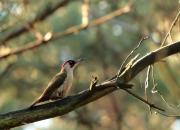info
I cannot remember how many times I have set out „for the green woodpecker”. I had seen it many times, but to take a picture of it was a totally different thing. It is very skittish and perhaps very rare, as while looking for it I had taken lots of pictures of the great woodpecker, the middle one, or the lesser one, but never the green woodpecker itself. The green woodpecker is quite extraordinary, as it eats mainly ants, and it can’t do without formic acid in its menu. It often feeds on the ground, digging around anthills. It does it even in winter. I’m under its spell, and I can assure you that this photo gallery will expand with time, of course to the extent to which the green woodpecker let me – we will see…
Last minute news 07/2013
What a great joy, finally we have green woodpecker’s gallery fulfilled with more than one photo. Their quality is not satisfying enough but the difficulty in taking photos of green woodpeckers is that we have to find their favourite anthill, the place of feeding and wait patiently for them to take a good photo. Otherwise this is the case of our good fortune or a sort of coincidence. I am not content with those photos and I will certainly continue photographing woodpeckers as I have a weakness for those beautiful, not too small, secret birds. Though their secrecy is not so obvious, as I could see them occasionally at the edge of human settlements, where they have been flying nearly over my head. But taking worthy photos is not as simple as that. So in the subject of this species I have not give up yet and this is the case of time when I present beautiful pictures suitable for woodpeckers.
Last minute news-10/2013
Finally there’s a radical improvement of the so far documentary pictures of the European green woodpecker. I admire this bird, but still I’m unable to get shots of it similar to those I managed to take of the tawny pipit during the first session. An ironic twist of fate is the fact that I had tried to take photos of a European green woodpecker many times, and with poor or documentary results, as you see. This time however, while I was sitting on a pulpit waiting for red deer (one came along), a few dozen meters away, on the right side, I spotted a preying European green woodpecker. A few dozen meters is a little too much of a distance for a middle-sized bird, but without a doubt these are the best pictures of a green woodpecker which I have taken, especially the ones with its long tongue pulled out. I hope I will have a chance to improve the photos of this magnificent bird presented here, although the latest shots already make the gallery varied, where you can admire the green woodpecker in a few shots. I invite you to take a look.
Last minute news-05/2014
Observing the European Bee-eaters, I suddenly saw a Green Woodpecker land to the right side of my hide. Several photos of it supplement the gallery, which is being formed very slowly and does not reflect the beauty of the bird. But since I succeeded in the Corn Crake I hope to take photos of the woodpecker in the future ...
Last minute news 07/2014
I was trying to capture the green woodpecker many times and finally the day of a radical change in the gallery has come. Since morning we both together with Robert (my greetings to you) tried to find the Greenish Warbler, but we not only missed the best light but also did not manage to photograph anything. We went to a place where green woodpeckers were likely to feed. And they actually were. Woodpeckers did not mind me taking photos. It was a little unfortunate that they were juveniles and not beautifully colored in early spring adult birds. However I left only few old photos in my gallery, and new ones of a better quality and quantity form the gallery.
Last minute news- 11/2017
The pictures of the green woodpecker might not be spectacular, but I had to add one of them as a memo of my encounter of the Iberian subspecies of this bird. The difference between our woodpecker and the one that occurs on the Iberian Peninsula is such that the Picus sharpei doesn’t have a black rim around its eye.
Hiszpania- 11/2017 ANGIELSKI
Bonelli's eagle - introduction text – Spain 11/2017
Birds-new galleries:
1. Bonelli's Eagle. 2. Black Wheatear. 3. Thekla Lark.
Changes in birds galleries:
1. Blue Rock Thrush.2. Common kestrel. 3. Northern goshawk. 4. Sardinian Warbler. 5. Southern Grey Shrike. 6. Hoopoe.7. Rock Sparrow. 8. Eurasian blackcap. 9. European robin. 10. Coal tit. 11. European green woodpecker. 12. Black redstart.13. Rock bunting.14. Dunnock. 15. Crested Tit.16.Common Blackbird.17.Eurasian Sparrowhawk. 18.Eurasian Collared Dove.
Go to the gallery : SPAIN FAUNA


